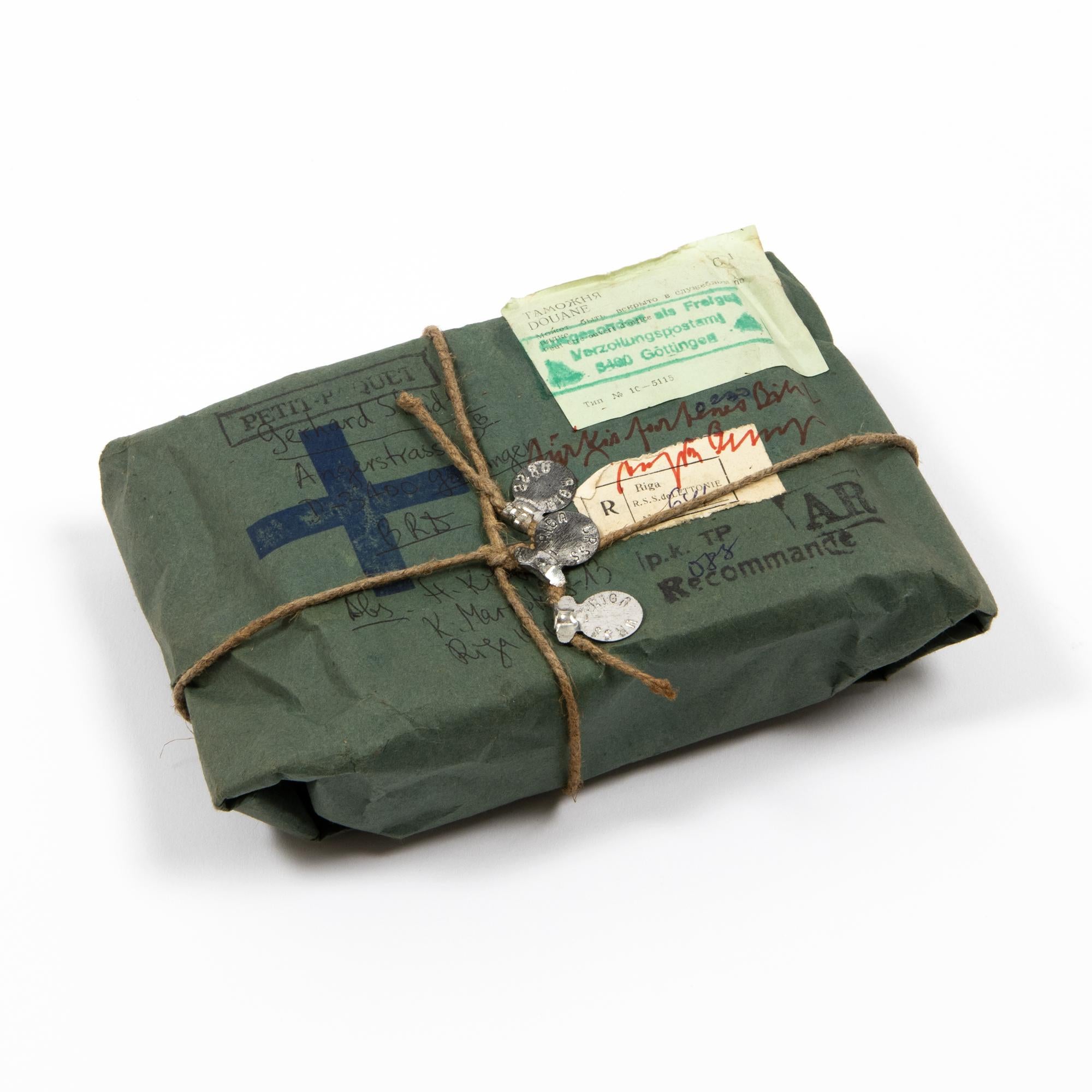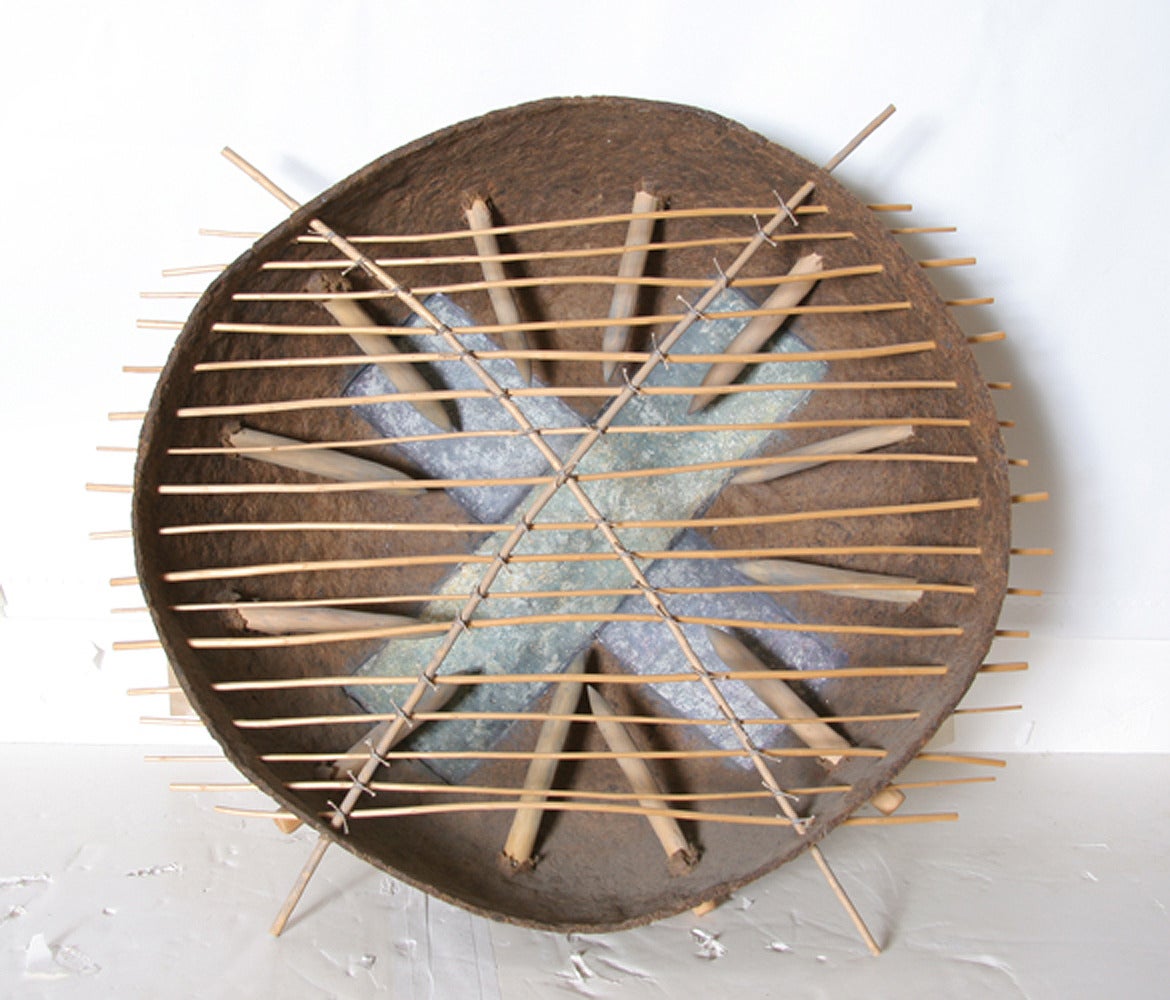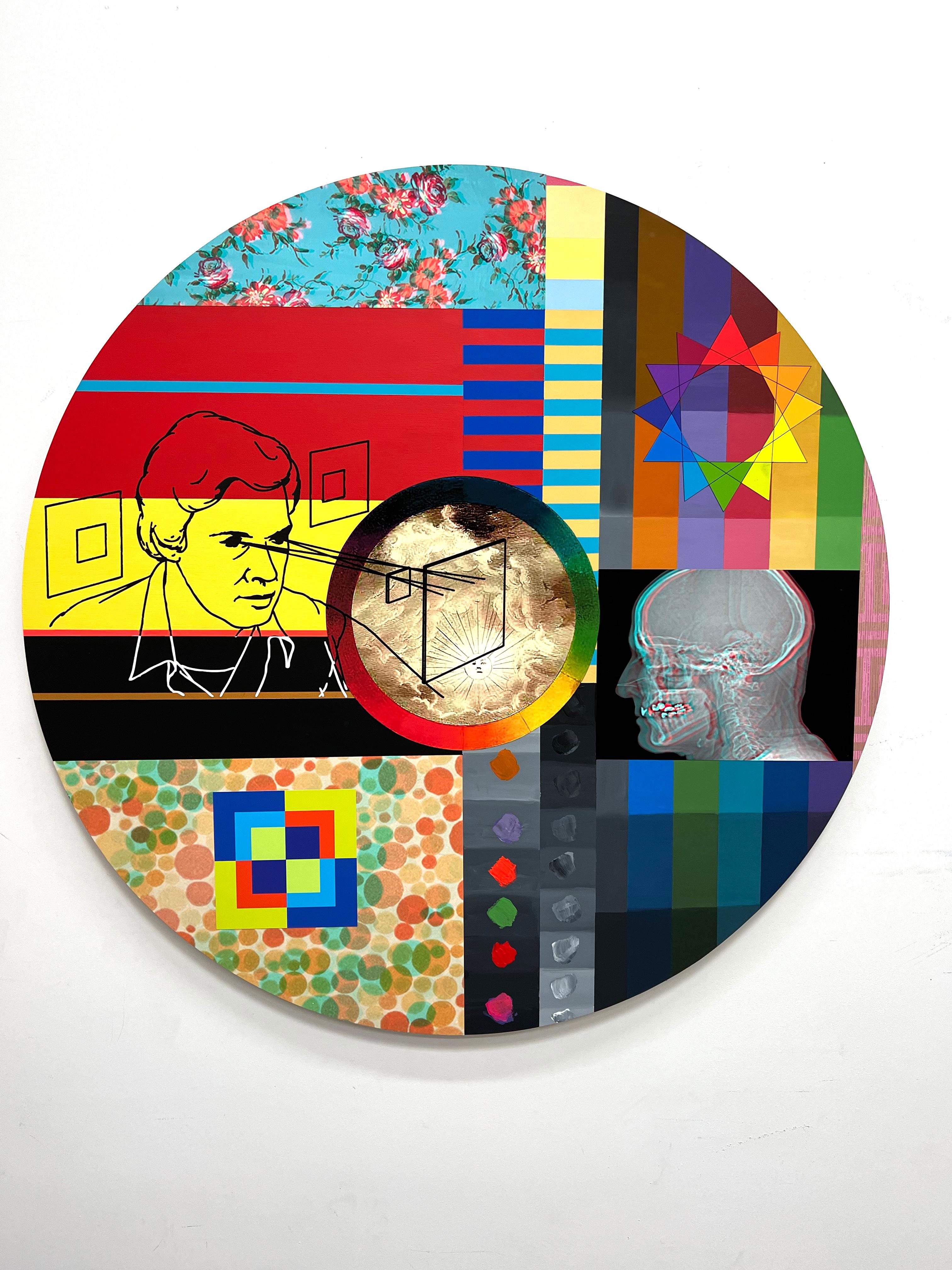Items Similar to MIxed Media Conceptual Art Sculpture Drawing Human Rights Welded Iron
Want more images or videos?
Request additional images or videos from the seller
1 of 9
Francoise ScheinMIxed Media Conceptual Art Sculpture Drawing Human Rights Welded Ironc.1990's
c.1990's
About the Item
This is a large sculpture and also includes an artist custom framed silkscreen with extensive handwork titled Line of Time, pencil signed and inscribed, presented in heavy metal and wooden frame (framed piece 24.5 x 30 in., sculpture piece is about 94 X 11 inches)
Francoise Schein is a visual artist, trained as an architect - urban planner; She also teaches art at the ESAM Higher School of Arts and Media in Caen in Normandy . She is the founder of the INSCRIRE Association.
In 2016, she was elected member of the Royal Academy of Sciences, Arts and Fine Arts of Belgium.
Group Exhibitions
Spain: 2016, The "5Contemporary" Paris gallery presented a group show at the Museum of Contemporary Art of Genalguacil, Spain. The show included important artists such as Françoise Schein, Mimouni and Pedro Castrortega.
Born in Brussels , Françoise Schein left Belgium after studying architecture at the higher institute of architecture of the French community - La Cambre where she wrote her thesis on fundamental rights, then studied urban design at the Columbia University in the City of New York . She lived 11 years in New York where she begins a work on cartography territories. Subway map Floating on NY Sidewalk is his first monumental urban sculpture located at 110 Greene Street in SoHo (1985). At that time her works are abstract landscapes of cities, made up of networks, lines, trajectories, territories, founding texts and stories. They are constructed of very diverse materials and light.
Returning back to Europe in 1989, she continues to work on what she calls her drawings-laboratories while beginning to integrate works in cities on civic themes, the main ones: at the Concorde metro station in Paris in 1991 and then in Brussels, Saint-Gilles , in 1992, these two projects took her to Lisbon in 1993 where she lived for five years and produced two monumental works (in azulejos) for the city of Lisbon at Parque metro station ( 1994) and another for the city of Stockholm at the Universitetet station (1998). She continues to travel to cities where she builds successively projects in Haifa , on the facade of the Beth Hagefen Jewish-Arab Cultural Center with Michel Butor (1994). Then she lives in Berlin where she builds the Westhafen station (2000) which takes her to Bremen to make her first human rights park, Rhododendronpark (2002). In 2005, she made the monumental Time Zone Clock in Coventry in 2005. Since 1999, she has also settled in Rio de Janeiro and initiated participatory artistic projects with the underprivileged population of the favelas . Since then, with the help of a locally trained team, many projects have been carried out, including one in Copacabana and more than 20 in different favelas (from 1999 to 2016). These works transformed the Rio workshop into sustainable development for the people who invested it. In Sao Paulo, since 2009, Françoise Schein has produced a monumental work with the participation of 1000 young people from the favela schools at Luz subway station.
Her work is monumental recalling the works of Christo, Maria Dompe, Christian Boltanski, Anish Kapoor, Ai Wei Wei and others in her use of size and landscape incorporating them into her work.
In Europe, Françoise Schein works with the Association Inscrire and with the Centro de Informação Europeia Jacques Delors (CIEJD) in Lisbon , to distribute an educational kit of reflections and artistic creation on the notion of citizenship, addressed to secondary schools . Since 2003, this educational project has already been carried out in many cities and schools in France, Belgium, England, Portugal and Spain. Ramallah is, of course, on the path of the artist ... In Port-au-Prince in Haiti, she works on her projects with the NGO Fokal.
In 2014, the CIVA Museum of Brussels - International Center for the City and Architecture - dedicates a retrospective which was then presented to the MAB-FAAP Museum of Sao Paulo in 2015, Museum of Brazilian Art - Armando Foundation Alvares Penteado. This exhibition will be presented at the National Historical Museum of Rio de Janeiro in 2017.
Françoise Schein is fluent in English and Portuguese , in addition to French . It is these 20 years of artistic work and public works that have given her the desire to share her knowledge of an urban team work experience. In 1997 , she founded the Association Register to produce citizen projects in disadvantaged areas, such as favelas in Brazil or the European suburbs.
In parallel with her participatory and social artistic works with the Association Inscription, Françoise Schein develops her own works, sculptures, cartographic photos-drawings and videos to express the encounters of a world no longer composed only of territories and abstract networks, but of complex knowledge and very powerful human links.
- Creator:Francoise Schein (1953, Belgian)
- Creation Year:c.1990's
- Dimensions:Height: 94 in (238.76 cm)Width: 11 in (27.94 cm)
- Medium:
- Movement & Style:
- Period:
- Condition:minor wear, minor wear to sculpture, not sure what is intended letters are shaped on piece but not present.
- Gallery Location:Surfside, FL
- Reference Number:1stDibs: LU38213369382
About the Seller
4.9
Platinum Seller
These expertly vetted sellers are 1stDibs' most experienced sellers and are rated highest by our customers.
Established in 1995
1stDibs seller since 2014
1,546 sales on 1stDibs
Typical response time: 1 hour
- ShippingRetrieving quote...Ships From: Surfside, FL
- Return PolicyA return for this item may be initiated within 3 days of delivery.
More From This SellerView All
- Russian Samizdat Art Conceptual Photo Sculpture Assemblage Gerlovin & GerlovinaLocated in Surfside, FLRimma Gerlovina and Valeriy Gerlovin Clock, 1987-94 Aluminum sculpture, mixed media and c-print photograph construction, c-print, felt tip marker 13 h × 13 w × 4 d in (30 × 30 × 6 cm) Rimma Gerlovina and Valeriy Gerlovin were founding members of the underground conceptual movement Samizdat in the Soviet Union, described in their book Russian Samizdat Art. Based on a play of paradoxes, their work is rich with philosophic and mythological implications, reflected in their writing as well. Their book Concepts was published in Russia in 2012. The work by Rimma Gerlovina and Valeriy Gerlovin is emphatically contemporary. The artist couple were part of the Moscow Conceptualists, their performance Costumes, from 1977, deepened their ongoing work with linguistic semiotic systems and their own bodies. Considering the context in which Gerlovina and Gerlovin made their work—that of political restrictions on public life, of unfreedom, and censorship—their collaborative togetherness must also be read as a space of possibility for political community and resistance. Rimma Gerlovina’s hair is featured prominently in the art of the Gerlovins as a constructing element of the body. Used for the linear drawings her braids transmit transpersonal waves reminiscent of an aura of live filaments. Long loose hairs function as threads of life; streaming in abundance, they allude to Aphrodisiac vitality and Samsonian strength. On the other hand, they are the haircloth worn during mourning and penitence. In New York they continued to make sculptural objects, and their photographic projects grew into an extended series called Photoglyphs. In their photographs, they use their own faces to explore the nature of thought and what lies beyond it. Since coming to the United States in 1980, they had many exhibitions in galleries and museums including the Art Institute of Chicago. The New Orleans Museum of Art launched a retrospective of their photography, which traveled to fifteen cities. Group exhibitions include the Venice Biennale, the Guggenheim Museum, New York, Smithsonian National Museum of American Art, Washington D.C., Bonn Kunsthalle, Germany, Tokyo Metropolitan Museum of Photography, State Tretyakov Gallery, Moscow, and others. Samizdat or “self-published” began in the Soviet Union, and Samizdat art consists mainly of books and magazines published and distributed by the artists who made them. Samizdat art has sources in the innovative books and magazines turned out by the early 20th century Russian avant-garde—artists and writers like Olga Rozanova, Vladimir Mayakovsky, El Lissitzky, and Alexander Rodchenko. Artists as varied as Alexander Archipenko, Leon Bakst, Marc Chagall, Naum Gabo, Alexandra Exter...Category
1980s Conceptual Figurative Photography
MaterialsMetal
- Alkyd Enamel Oil Painting Half A Thought Cut Panel Wall Hanging Modern SculptureBy Peter WegnerLocated in Surfside, FLOil-based alkyd enamel on plywood panel with cuts. this is a cut plywood wall relief sculpture with paint on it. This has an architectural quality to it. Peter Wegner (born 1963) is an American artist whose works consist of painting, photograph, collage, prints, artist's books, and large-scale installations Born in Sioux Falls, South Dakota, Peter Wegner earned his BA at Yale University. He works in multiple media, ranging from paintings and photography to large-scale installations and wall works. His pieces are included in major public and private collections worldwide. He currently lives and works in Berkeley, California. A core theme in Wegner's work is color. Professor, author, and critic Eve Meltzer noted in a 2002 review that “color may be the… center” of his entire practice. The artist first began deconstructing the subject in the late 1990s with his "Remarks on Color" series, which used commercial paint chip samples as their starting point. Another theme identified by experts is Wegner's engagement with architecture. For example, in his photography series "Buildings Made of Sky," Wegner reverses urban streetscapes to reveal how skyscrapers shape the open-air spaces between one another into skyscraper-like forms of their own. Wegner has also often pushed the construction of his works in an architectural direction, presenting paintings in the form of leaning columns, complex lattices, and multi-layered scrims. Huldisch noted that “[h]is stacks, grids, and lattice structures reveal both an interest in the forms of Minimalism and a rejection of the stringent doctrine that predicated them." Wegner's early work focuses on everyday artifacts embedded in popular culture, including typography specimens (the basis for the "American Types" series), commercial paint chips (in the "Remarks on Color" series), and security envelopes (in the "Security" series). Wegner produced in 2005 the "Lever Labyrinth," a human-scale maze composed of 2.2 million sheets of stacked paper––all in various shades of green, creating columns of subtly gradating color––constructed inside the Lever House building. In 2008, Wegner executed the major paper installation "GUILLOTINE OF SUNLIGHT, GUILLOTINE OF SHADE" at the San Francisco Museum of Modern Art. The piece consisted of 1.4 millions sheets of die-cut paper in 40 hues, arranged to create two 12’ x 26.5’ x 7" color gradations inside the museum: a wall progressing from blue to yellow in one gallery, and a wall progressing from yellow to red in another. Around this same time, Wegner introduced two new elements into his work: time and neon. He combined both in 2007 to create “THE UNITED STATES OF NOTHING,” which included time-controlled neon signage showing the name, latitude, and longitude of every U.S. city that invokes the concept of nothingness. He has showed at William Griffin Gallery. The gallery has featured solo exhibitions by James Turrell, Richard Long, Robert Rauschenberg, David Lynch, Ed Ruscha, Richard Serra, Tony Smith, Peter Wegner, Greg Colson, Liza Ryan and others. It has presented group exhibitions such as Early California Minimalism, a survey of significant early works by Robert Irwin, John McCracken, and Craig Kauffman; and Wall Installations, with works by Maya Lin, James Turrell, Richard Long, Robert Therrien, Teresita Fernández, Karin Sander, Peter Wegner, and Kira Lynn Harris. It has also presented projects of work by Richard Tuttle, Ana Mendieta...Category
21st Century and Contemporary Conceptual Abstract Paintings
MaterialsEnamel
- Russian Samizdat Art Conceptual Compass Sculpture Assemblage Gerlovin, GerlovinaLocated in Surfside, FLRimma Gerlovina and Valeriy Gerlovin Compass, 1988 Aluminum sculpture, mixed media and c-print photograph construction, c-print, felt tip marker 12.5 h × 12.5w × 4 d in (30 × 30 × 6 cm) Rimma Gerlovina and Valeriy Gerlovin were founding members of the underground conceptual movement Samizdat in the Soviet Union, described in their book Russian Samizdat Art. Based on a play of paradoxes, their work is rich with philosophic and mythological implications, reflected in their writing as well. Their book Concepts was published in Russia in 2012. The work by Rimma Gerlovina and Valeriy Gerlovin is emphatically contemporary. The artist couple were part of the Moscow Conceptualists, their performance Costumes, from 1977, deepened their ongoing work with linguistic semiotic systems and their own bodies. Considering the context in which Gerlovina and Gerlovin made their work—that of political restrictions on public life, of unfreedom, and censorship—their collaborative togetherness must also be read as a space of possibility for political community and resistance. Rimma Gerlovina’s hair is featured prominently in the art of the Gerlovins as a constructing element of the body. Used for the linear drawings her braids transmit transpersonal waves reminiscent of an aura of live filaments. Long loose hairs function as threads of life; streaming in abundance, they allude to Aphrodisiac vitality and Samsonian strength. On the other hand, they are the haircloth worn during mourning and penitence. In New York they continued to make sculptural objects, and their photographic projects grew into an extended series called Photoglyphs. In their photographs, they use their own faces to explore the nature of thought and what lies beyond it. Since coming to the United States in 1980, they had many exhibitions in galleries and museums including the Art Institute of Chicago. The New Orleans Museum of Art launched a retrospective of their photography, which traveled to fifteen cities. Group exhibitions include the Venice Biennale, the Guggenheim Museum, New York, Smithsonian National Museum of American Art, Washington D.C., Bonn Kunsthalle, Germany, Tokyo Metropolitan Museum of Photography, State Tretyakov Gallery, Moscow, and others. Samizdat or “self-published” began in the Soviet Union, and Samizdat art consists mainly of books and magazines published and distributed by the artists who made them. Samizdat art has sources in the innovative books and magazines turned out by the early 20th century Russian avant-garde—artists and writers like Olga Rozanova, Vladimir Mayakovsky, El Lissitzky, and Alexander Rodchenko. Artists as varied as Alexander Archipenko, Leon Bakst, Marc Chagall, Naum Gabo, Alexandra Exter...Category
1980s Conceptual Figurative Photography
MaterialsMetal
- Gentleman, Marble and Travertine Conceptual SculptureBy Maria DompeLocated in Surfside, FLMARIA DOMPE, (Italian, b. 1958), Gentleman Sculpture, marble and travertine, 1995, height: 20 in. One of a pair, (Gentleman and Lady) being sold separately. Maria Dompe was born in ...Category
Late 20th Century Conceptual Abstract Sculptures
MaterialsTravertine, Marble
- Lady, Marble and Fabric Conceptual Abstract Sculpture Maria DompeBy Maria DompeLocated in Surfside, FLMARIA DOMPE, (Italian, b. 1958), Lady Sculpture, marble and fabric, 1995, height: 14 in. One of a pair, (Lady and Gentleman) being sold separately. Maria Dompe was born in Fermo on ...Category
Late 20th Century Conceptual Abstract Sculptures
MaterialsMarble
- Large Abstract Landscape Pastel Drawing Painting San Francisco Artist, Megan #13By Dennis LeonLocated in Surfside, FLIt has a variegated texture to it. It is signed and titled. Large format drawing or painting in pastel or crayon. pastoral landscape with boulders and rocks in pasture. Dennis Leon, was a San Francisco Bay Area sculptor and art instructor Mr. Leon was chairman of the sculpture department at the California College of Arts and Crafts in Oakland from 1972 to 1988. He remained a faculty member until his retirement as professor emeritus in 1993. A vibrant work in pastel with the energy and texture seen in the work of Wolf Kahn. He was born in London, England and emigrated in 1951 to the United States, where he studied at Temple University in Philadelphia. He graduated with art degrees, including a master's degree in fine art. He served in the U.S. Army and the Army Reserve from 1957 to 1963. In 1959, Mr. Leon joined the faculty of the Philadelphia Museum College of Art. He also worked as an art critic for the Philadelphia Inquirer until 1962. After coming to the Bay Area, he held his first local one-man show of sculpture in 1973, at the James Willis...Category
20th Century American Modern Abstract Sculptures
MaterialsOil Crayon, Oil Pastel, Archival Paper
You May Also Like
- Limpopo, 2021By Michael DavisLocated in Palm Desert, CAStyle: Contemporary, Modern, Conceptual Small study for the series “Rare Earth"Category
21st Century and Contemporary Conceptual Abstract Sculptures
MaterialsMetal
- Joseph Beuys, Türkisfarbenes Bild - Unique Sculptural Object, Signed and titledBy Joseph BeuysLocated in Hamburg, DEJoseph Beuys (German, 1921-1986) Türkisfarbenes Bild, ca. 1974 Medium: Kraft paper, rope, pencil, ink, stamps, stickers and metal tags Dimensions: 5 x 18.5 x 12.3 cm Unique artwork: ...Category
20th Century Conceptual Abstract Sculptures
MaterialsMetal
- Joseph Beuys, Türkisfarbenes Bild - Unique Sculpture, Hand-signed, FluxusBy Joseph BeuysLocated in Hamburg, DEJoseph Beuys (German, 1921-1986) Türkisfarbenes Bild, ca. 1974 Medium: Kraft paper, rope, pencil, ink, stamps, stickers and metal tags Dimensions: 5 x 18.5 x 12.3 cm Unique artwork: ...Category
20th Century Conceptual Abstract Sculptures
MaterialsMetal
- Vessel: Pierced III, Unique Wall or Table Art by Sylvia SeventyBy Sylvia SeventyLocated in Long Island City, NYThis mixed media sculpture by Sylvia Seventy, from 1986, is a conceptual work in neutral tones. Materials include handmade paper, Apple Wood, Willow, Paint, Oil Pastel, Wax, Cotton ...Category
1980s Conceptual Abstract Sculptures
MaterialsCotton, Handmade Paper, Oil Pastel, Paint, Wood
- Color Theory 2022 Contemporary collageBy Michael DavisLocated in Palm Desert, CAStyle: Contemporary, Modern, Conceptual The artwork is an assembly of art fundamental theories in juxtaposition with patterns, shapes and archival digital prints illustrating phenome...Category
21st Century and Contemporary Conceptual Mixed Media
MaterialsFabric, Plywood, Paint, Paper, Digital
- Surrender Your Fantasies For Something BetterBy Kevin KeglerLocated in Buffalo, NYAn original conceptual sculpture by Kevin Kegler. This work is currently featured in the artist's solo exhibition inside The Corridors Gallery at Hotel Henry.Category
2010s Conceptual Abstract Sculptures
MaterialsCopper





